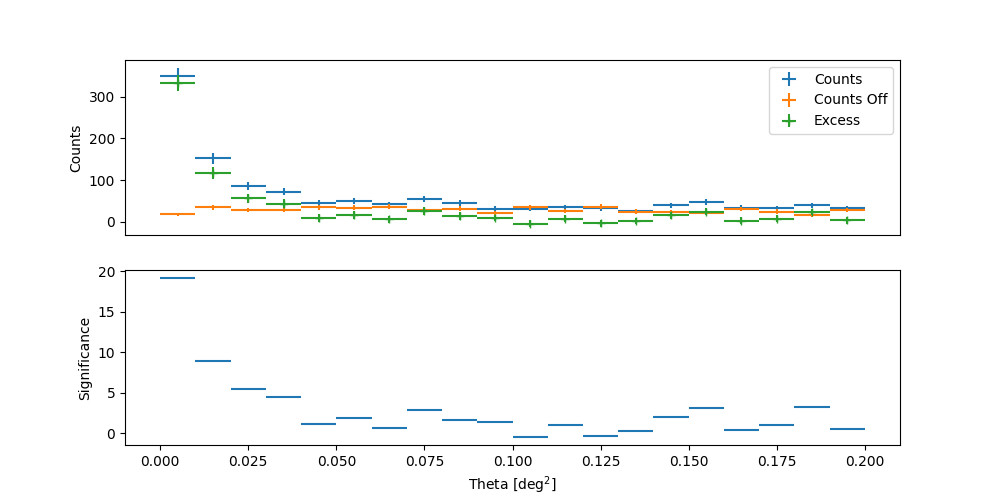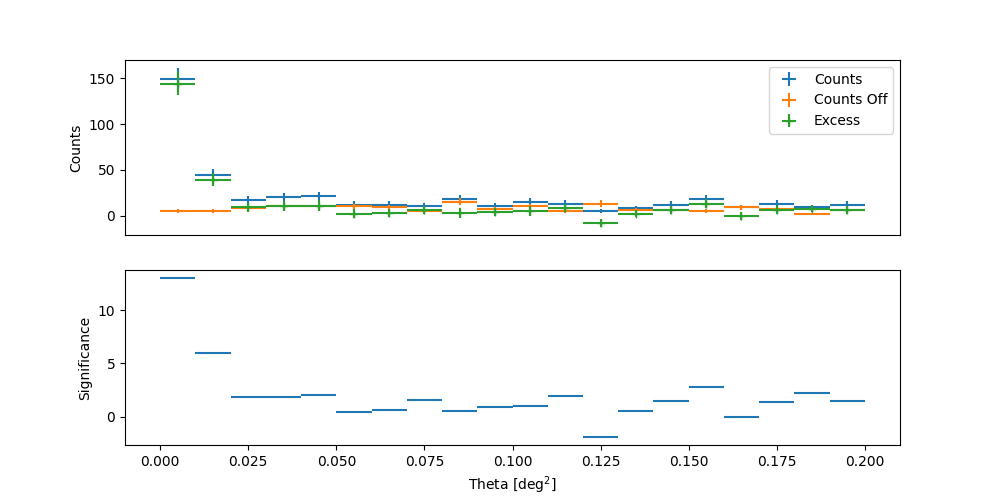Note
Go to the end to download the full example code. or to run this example in your browser via Binder
Make a theta-square plot#
This tutorial explains how to make such a plot, that is the distribution of event counts as a function of the squared angular distance, to a test position.
Setup#
# %matplotlib inline
import matplotlib.pyplot as plt
from astropy.coordinates import SkyCoord
from astropy import units as u
from gammapy.data import DataStore
from gammapy.maps import MapAxis
from gammapy.makers.utils import make_theta_squared_table
from gammapy.visualization import plot_theta_squared_table
Check setup#
from gammapy.utils.check import check_tutorials_setup
check_tutorials_setup()
System:
python_executable : /home/runner/work/gammapy-docs/gammapy-docs/gammapy/.tox/build_docs/bin/python
python_version : 3.9.22
machine : x86_64
system : Linux
Gammapy package:
version : 2.0.dev1305+g5f0ae82af
path : /home/runner/work/gammapy-docs/gammapy-docs/gammapy/.tox/build_docs/lib/python3.9/site-packages/gammapy
Other packages:
numpy : 1.26.4
scipy : 1.13.1
astropy : 6.0.1
regions : 0.8
click : 8.1.8
yaml : 6.0.2
IPython : 8.18.1
jupyterlab : not installed
matplotlib : 3.9.4
pandas : not installed
healpy : 1.17.3
iminuit : 2.31.1
sherpa : 4.16.1
naima : 0.10.0
emcee : 3.1.6
corner : 2.2.3
ray : 2.46.0
Gammapy environment variables:
GAMMAPY_DATA : /home/runner/work/gammapy-docs/gammapy-docs/gammapy-datasets/dev
Get some data#
Some data taken on the Crab by H.E.S.S. are used.
data_store = DataStore.from_dir("$GAMMAPY_DATA/hess-dl3-dr1")
observations = data_store.get_observations([23523, 23526])
Define a test position#
position = SkyCoord.from_name("crab")
print(position)
<SkyCoord (ICRS): (ra, dec) in deg
(83.6324, 22.0174)>
Creation of the theta2 plot#
theta2_axis = MapAxis.from_bounds(0, 0.2, nbin=20, interp="lin", unit="deg2")
theta2_table = make_theta_squared_table(
observations=observations,
position=position,
theta_squared_axis=theta2_axis,
)
plt.figure(figsize=(10, 5))
plot_theta_squared_table(theta2_table)
plt.show()

Making a theta2 plot for a given energy range#
with the function make_theta_squared_table, one can also select a fixed energy range.
theta2_table_en = make_theta_squared_table(
observations=observations,
position=position,
theta_squared_axis=theta2_axis,
energy_edges=[1.2, 11] * u.TeV,
)
plt.figure(figsize=(10, 5))
plot_theta_squared_table(theta2_table_en)
plt.show()

Statistical significance of a detection#
To get the significance of a signal, the usual method consists of using the reflected background method (see the maker tutorial: Reflected regions background) to compute the WStat statistics (see WStat : Poisson data with background measurement, Fit statistics). This is the well-known method of Li&Ma [LiMa1983] using ON and OFF regions. The following tutorials show how to get an excess significance:
